» posted on Monday, September 23rd, 2013 by Linda Lou Burton
Part Of The Process
 Linda Burton posting from Augusta, Maine – “There’s not much legroom under the desks,” said Dan, pulling out the wastebasket for us to see, “so people tend to set these behind their chairs.” He proceeded to demonstrate how crowded that made the walking space for getting in and out. “Big feet like mine are prone to trip,” he continued, “but little kids can zip through in a flash.” Dan Fournier, our guide in the Maine State House this morning, was explaining the Honorary Page Program, which allows even very young Maine students to spend a day working in the
Linda Burton posting from Augusta, Maine – “There’s not much legroom under the desks,” said Dan, pulling out the wastebasket for us to see, “so people tend to set these behind their chairs.” He proceeded to demonstrate how crowded that made the walking space for getting in and out. “Big feet like mine are prone to trip,” he continued, “but little kids can zip through in a flash.” Dan Fournier, our guide in the Maine State House this morning, was explaining the Honorary Page Program, which allows even very young Maine students to spend a day working in the 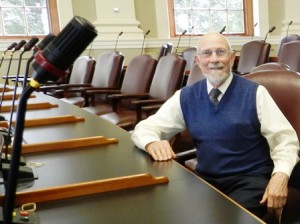 legislature during session. “Their job is to deliver messages, or documents, to the legislators,” he said. “And they love it. They don’t just observe what happens here, they are part of the process.” Our tour group today included State Representative Thomas Longstaff, one of Maine’s 151 legislators. As we sat in the House Chambers he added his comments, pointing out the colored bands on the desk microphones. “They designate what paper materials we want to receive,” Tom explained. “I have chosen to go paperless, using my laptop for retrieving the documents we need. If a mike has a yellow band, for instance, that
legislature during session. “Their job is to deliver messages, or documents, to the legislators,” he said. “And they love it. They don’t just observe what happens here, they are part of the process.” Our tour group today included State Representative Thomas Longstaff, one of Maine’s 151 legislators. As we sat in the House Chambers he added his comments, pointing out the colored bands on the desk microphones. “They designate what paper materials we want to receive,” Tom explained. “I have chosen to go paperless, using my laptop for retrieving the documents we need. If a mike has a yellow band, for instance, that  person chooses to receive a paper copy of a bill.” I looked around the room, noting yellow bands on mikes. Tom called our attention to the electronic voting board in the corner too; “In addition to the 151 legislator names,” he pointed out, “there are three more names at the bottom that represent the Maliseet, Penobscot, and Passamaquoddy tribes of Maine, and even though they are non-voting members, they have the right to speak, and introduce legislation. They are part of the process.” Our attention switched from the building itself to what happens inside of it; questions began to fly.
person chooses to receive a paper copy of a bill.” I looked around the room, noting yellow bands on mikes. Tom called our attention to the electronic voting board in the corner too; “In addition to the 151 legislator names,” he pointed out, “there are three more names at the bottom that represent the Maliseet, Penobscot, and Passamaquoddy tribes of Maine, and even though they are non-voting members, they have the right to speak, and introduce legislation. They are part of the process.” Our attention switched from the building itself to what happens inside of it; questions began to fly.
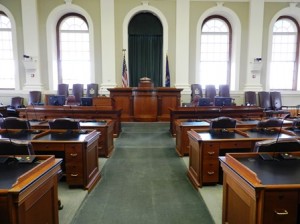 Maine has a part-time citizen Legislature, tour guide Dan explained; it meets for about six months during its first regular session, and about four months during the second. During Session, the public is invited to observe from the back of the Chambers or from the Gallery; and students from third grade through high school can be a part of the legislative process through the Honorary Page program. Under the supervision of the Sergeant-At-Arms and Chamber Staff, Honorary Pages have the opportunity to see what it’s like to work on the floor, delivering messages and distributing amendments and supplements. Cameras and camcorders are
Maine has a part-time citizen Legislature, tour guide Dan explained; it meets for about six months during its first regular session, and about four months during the second. During Session, the public is invited to observe from the back of the Chambers or from the Gallery; and students from third grade through high school can be a part of the legislative process through the Honorary Page program. Under the supervision of the Sergeant-At-Arms and Chamber Staff, Honorary Pages have the opportunity to see what it’s like to work on the floor, delivering messages and distributing amendments and supplements. Cameras and camcorders are 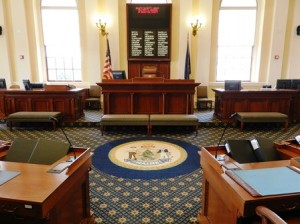 allowed in visitor areas of the chamber during Session; before and after Session and during recesses, Pages may go to the podium for pictures, or try their hand with the gavel. Students may sign up online to become an Honorary Page. People can watch a live stream of Session happenings too. All proceedings are recorded; a camera automatically focuses on a legislator from the moment they are recognized and begin to speak. And any citizen may introduce an idea for a legislative bill. “It’s a complex process,” Dan said, “with many steps. But it works.”
allowed in visitor areas of the chamber during Session; before and after Session and during recesses, Pages may go to the podium for pictures, or try their hand with the gavel. Students may sign up online to become an Honorary Page. People can watch a live stream of Session happenings too. All proceedings are recorded; a camera automatically focuses on a legislator from the moment they are recognized and begin to speak. And any citizen may introduce an idea for a legislative bill. “It’s a complex process,” Dan said, “with many steps. But it works.”
 Being part of the process. As we walked around the capitol, Dan pointed to the many portraits; telling stories of those who have been involved in Maine government since government in Maine began. Like Sir William Phips (1650-1695), the first colonial governor of Maine. Sir William, born in Woolwich, was the youngest of 26 children; he started humble work as a shepherd and spent much time with the Abenaki natives. Then he moved to Boston and worked as a ship’s carpenter, married, and became a sea captain. He led a successful treasure-hunting expedition to the Caribbean, was knighted by King James II, and became Royal Governor of the Province of Massachusetts. This was the time of the Salem “witch hunts;” Sir William put an end to the accusations and released the majority of the accused.
Being part of the process. As we walked around the capitol, Dan pointed to the many portraits; telling stories of those who have been involved in Maine government since government in Maine began. Like Sir William Phips (1650-1695), the first colonial governor of Maine. Sir William, born in Woolwich, was the youngest of 26 children; he started humble work as a shepherd and spent much time with the Abenaki natives. Then he moved to Boston and worked as a ship’s carpenter, married, and became a sea captain. He led a successful treasure-hunting expedition to the Caribbean, was knighted by King James II, and became Royal Governor of the Province of Massachusetts. This was the time of the Salem “witch hunts;” Sir William put an end to the accusations and released the majority of the accused.
Like John Neptune (1767-1865), who served the Penobscot Nation for fifty years as their Lieutenant Governor. Author Fannie Hardy Eckstorm wrote this about Neptune in her 1945 book: “the strong man of the tribe, he stood for independence in thought and action….he did not waver in his friendship for the whites, his loyalty to the Union, his advocacy of education for his people…He channeled their thoughts and action into broader than tribal ways.” (Neptune’s original portrait, for which he sat in 1836, was painted on wood; it is stored for preservation and a framed print hangs in the Senate Chamber.)
 Like Hannibal Hamlin (1809-1891), born in Paris Hill; he helped manage the family farm, worked as a schoolmaster, and ran the local newspaper. In 1836 he began his political career, starting in Maine’s House of Representatives. He served as governor of Maine, and as US Senator from Maine; in 1860 he was chosen for Vice President on the Republican ticket. As Vice President, he worked closely with Abraham Lincoln, urging for the Emancipation Proclamation and the arming of African-Americans. He was not on the ticket for Lincoln’s second term (“If he had been, he would have become President instead of Andrew Johnson,” Dan pointed out). Hamlin returned to the US Senate until 1881.
Like Hannibal Hamlin (1809-1891), born in Paris Hill; he helped manage the family farm, worked as a schoolmaster, and ran the local newspaper. In 1836 he began his political career, starting in Maine’s House of Representatives. He served as governor of Maine, and as US Senator from Maine; in 1860 he was chosen for Vice President on the Republican ticket. As Vice President, he worked closely with Abraham Lincoln, urging for the Emancipation Proclamation and the arming of African-Americans. He was not on the ticket for Lincoln’s second term (“If he had been, he would have become President instead of Andrew Johnson,” Dan pointed out). Hamlin returned to the US Senate until 1881.
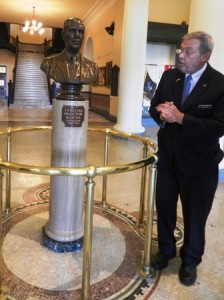 Like Percival Proctor Baxter (1876-1969), whose bust occupies center stage in the State House Hall of Flags. Percival Baxter was one of eight children born to James Phinney Baxter, a wealthy man who made his fortune in the canning industry. Percival graduated from Portland High School and Bowdoin College before law school at Harvard; then he went into the family business, and finally, into politics. He served in the Maine House of Representatives and the Maine Senate before becoming Governor in 1921. But his chief legacy to the state of Maine is what is known today as Baxter State Park. Between 1931 and 1962, Percival Baxter purchased and put into Trust 28 parcels of land totaling more than 200,000 acres in north-central Maine; set aside permanently as a wilderness area, for the use of the public. That’s where Maine’s tallest peak, Mt Katahdin, is located.
Like Percival Proctor Baxter (1876-1969), whose bust occupies center stage in the State House Hall of Flags. Percival Baxter was one of eight children born to James Phinney Baxter, a wealthy man who made his fortune in the canning industry. Percival graduated from Portland High School and Bowdoin College before law school at Harvard; then he went into the family business, and finally, into politics. He served in the Maine House of Representatives and the Maine Senate before becoming Governor in 1921. But his chief legacy to the state of Maine is what is known today as Baxter State Park. Between 1931 and 1962, Percival Baxter purchased and put into Trust 28 parcels of land totaling more than 200,000 acres in north-central Maine; set aside permanently as a wilderness area, for the use of the public. That’s where Maine’s tallest peak, Mt Katahdin, is located.
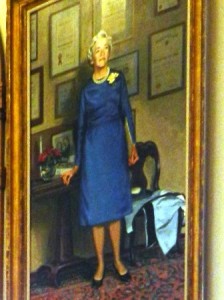 Like Margaret Madeline Chase Smith (1897-1995), born in Skowhegan, Maine. The oldest of six children, Margaret’s father George Chase was the town barber and her mother Carrie worked in a shoe factory. Margaret got her first job at age 12 in the local five-and-dime; she also helped in her father’s barber shop. She played basketball in high school, worked as a telephone operator, and married Clyde Smith, a local politician. Margaret went on to serve in the US House and Senate (1940-1973), the first woman to serve in both houses of Congress, and the first woman to represent Maine. She set a record for casting the largest number of consecutive roll call votes—2,941—which ended when she missed a vote because of back surgery. She was the first woman placed in nomination for the presidency; that was at the Republican convention of 1964, when Goldwater ultimately was selected for the party’s ticket.
Like Margaret Madeline Chase Smith (1897-1995), born in Skowhegan, Maine. The oldest of six children, Margaret’s father George Chase was the town barber and her mother Carrie worked in a shoe factory. Margaret got her first job at age 12 in the local five-and-dime; she also helped in her father’s barber shop. She played basketball in high school, worked as a telephone operator, and married Clyde Smith, a local politician. Margaret went on to serve in the US House and Senate (1940-1973), the first woman to serve in both houses of Congress, and the first woman to represent Maine. She set a record for casting the largest number of consecutive roll call votes—2,941—which ended when she missed a vote because of back surgery. She was the first woman placed in nomination for the presidency; that was at the Republican convention of 1964, when Goldwater ultimately was selected for the party’s ticket.
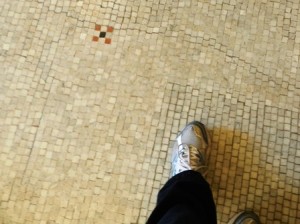 Dan pointed to Smith’s portrait as we looked around the Hall of Flags; then he pointed to the tiles on the floor beneath our feet: “See how tiny? These are the original tiles, placed here when construction began in 1829; it took two years to do them all.” Our attention switched back to the building again.
Dan pointed to Smith’s portrait as we looked around the Hall of Flags; then he pointed to the tiles on the floor beneath our feet: “See how tiny? These are the original tiles, placed here when construction began in 1829; it took two years to do them all.” Our attention switched back to the building again.
 The building was completed in 1832; it was designed by Charles Bulfinch, architect of the Boston capitol, and looked much like the Massachusetts building with a similar rounded dome. That dome no longer exists; in 1911 additions were made that necessitated removing the roof. The old rounded dome, which was patched and leaky, was replaced with a more vertical dome of steel frame construction. The new dome is topped with a statue of a draped female figure called Lady of Wisdom, made of copper plated with gold. Granite from
The building was completed in 1832; it was designed by Charles Bulfinch, architect of the Boston capitol, and looked much like the Massachusetts building with a similar rounded dome. That dome no longer exists; in 1911 additions were made that necessitated removing the roof. The old rounded dome, which was patched and leaky, was replaced with a more vertical dome of steel frame construction. The new dome is topped with a statue of a draped female figure called Lady of Wisdom, made of copper plated with gold. Granite from 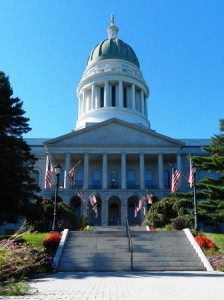 quarries at nearby Hallowell was used in the original construction, built at a cost of $139,000. Renovations, remodelings, additions, and new constructions have taken place over the years as Maine’s population grew, and Maine’s government expanded. There are 151 representatives now, and 35 senators. A group of buildings make up the State House Complex today, yet the original center section remains, its colonnaded portico high on a hill above the surrounding town, marking the spot where Maine’s legislature convened 181 years ago.
quarries at nearby Hallowell was used in the original construction, built at a cost of $139,000. Renovations, remodelings, additions, and new constructions have taken place over the years as Maine’s population grew, and Maine’s government expanded. There are 151 representatives now, and 35 senators. A group of buildings make up the State House Complex today, yet the original center section remains, its colonnaded portico high on a hill above the surrounding town, marking the spot where Maine’s legislature convened 181 years ago.
A genuinely historic building, I thought, as I date-stamped the card with a sketch of the Maine State House on the front. “Thank you for visiting Maine’s Capitol,” was printed on the bottom. As the Security Guards bid me goodbye, they suggested I take the elevator to the tunnel next; “Be sure to see the animals,” they said. The Klir Beck dioramas in the tunnel leading to the State Office Building are a favorite with visiting school kids; the mama bear and cub in a  springtime scene; the deer overlooking a tiny summer cottage far below; the autumn beaver working on a dam; the stately winter moose; I stopped to see. On to the Capitol Cafeteria, where a tour guide led a French-speaking group through the lunch line just ahead of me. French Onion was the Soup de Jour; I added an egg salad sandwich and took a spot in a booth near the back. It was pleasant there, sitting among visitors, and legislators, and governmental staff; just part of the process.
springtime scene; the deer overlooking a tiny summer cottage far below; the autumn beaver working on a dam; the stately winter moose; I stopped to see. On to the Capitol Cafeteria, where a tour guide led a French-speaking group through the lunch line just ahead of me. French Onion was the Soup de Jour; I added an egg salad sandwich and took a spot in a booth near the back. It was pleasant there, sitting among visitors, and legislators, and governmental staff; just part of the process.
Maine State House, 21 State Street, open Monday-Friday, tours call 207-287-2301.
